Cayuga Ducks & Muscovy Ducks
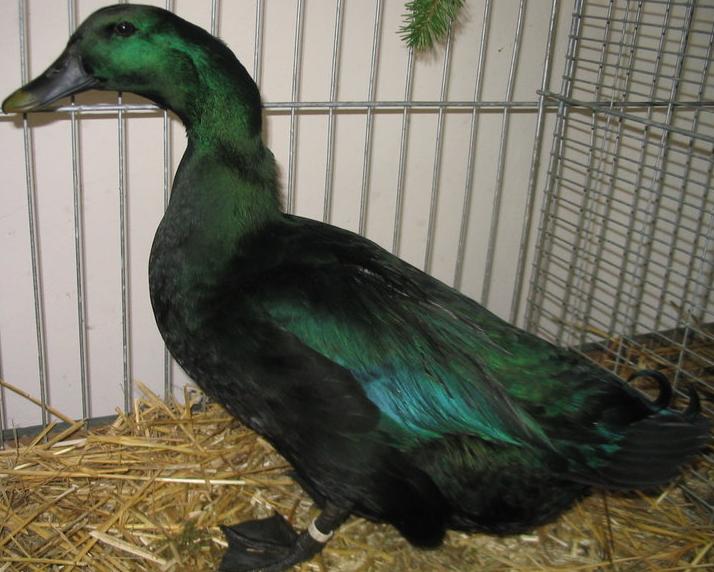
Cayuga Ducks/sold out
History
The first ducks were shown at the Great Exhibition at Crystal Palace in 1851. Their name is taken from Lake Cayuga in New York State. Lewis Wright talks of the original imports having been brownish black and many birds having a white irregular ring around the drakes neck. He states that the selective breeding initialy reduced the size which as he also puts the East Indies then as 4/5 pounds reinforces the idea of a common pedigree. By the 1890's the cayugas were measured at 19 pound per pair and resembling the Aylesbury in carriage. It carries the blood of the original wild black duck, the Black East Indies and probably some Rouen blood introduced for the purpose of larger size. The Cayuga should be bred to the meat type.
Characteristics
Kept as groups or alternatively trios . . . depending upon the drakes energy levels. They lay through the year normally starting in the spring and will brood their eggs if left to sit. The eggs are meant to be covered in a black / dark grey film which will wash off though many now lay white eggs.
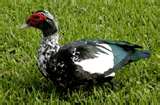
Muscovy Ducks
Characteristics
This is the only breed of domestic duck that is not decended from the mallard, being technically almost a goose. They are also strange in the fact that they do not quack, but make a hissing sound instead (males sometimes sound like heavy breathers!). Females chirp to their offspring and they are the supreme goose egg broody.
Breed Tips
Personality wise the nicest, daftest, stupidest sense of humour and clever with it . . . they communicate ways to escape / steal extra food etc . . . brilliant with dogs.
The fact that they are nearly silent can make them avery good choice if you have close neighbours. Sold often as a mutant cross as Barbary Duck . . . THE meat duck.
Origin
Mexico, Central, Southern America
price : $15 ducklings
$45 laying ducks
Pekin duck, or Long Island duck
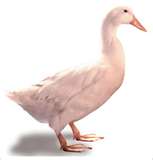
price : $12 ducklings
$25 laying ducks
Pekin duck/sold out
Long Island duck
History
(Anas platyrhynchos domestica, or Anas peking),
is a breed of domesticated duck used primarily for egg and meat production. It was bred from the Mallard in China. The ancestors of those ducks originated from the canals which linked waterways in Nanjing and originally had small bodies and black feathers. With the relocation of the Chinese capital to Beijing, supply barge traffic increased in the area which would often spill grain during trips the ducks fed. Over time, the ducks slowly increased in size and grew white feathers. By the Five Dynasties the new species of duck had been domesticated by Chinese farmers.
In 1873 nine ducks were exported from China to Long Island, New York in the United States and the animals and their meat are sometimes referred to as "Long Island duckling". It is the most popular commercial duck breed in the United States, although some farming has since relocated to Indiana from Suffolk County, New York. Around 95% of duck meat consumed in the United States is Pekin duck.
Blue Runner Ducks
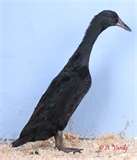
Characteristics:
The ducks vary in weight between 1.4 and 2.3 kg (3-4 ½ lbs). Their height (from crown to tail tip) ranges from 50 cm (20 inches) in small females to about 66 cm (26 inches) in the taller males. The eggs are often greenish-white in color, but these too vary.
Indian Runners love foraging. They also like swimming in ponds and streams, but they are likely to be preoccupied in running around grassy meadows looking for worms, slugs, even catching flies. They appreciate open spaces but are happy in gardens from which they cannot fly and where they make much less noise than Call Ducks. Only the females quack. All drakes are limited to a hoarse whisper. Runners eat less in the way of grain and pellet supplement than big table ducks. Of course, they should be given calcium and protein-rich food, especially the ducks during the extensive laying season.
price : $15 ducklings
$25 laying ducks
Mandarin Ducks
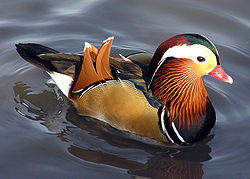
The Mandarin Duck (Aix galericulata), or just Mandarin, is a medium-sized perching duck, closely related to the North American Wood Duck. It is 41–49 cm long with a 65–75 cm wingspan.
The adult male is a striking and unmistakable bird. It has a red bill, large white crescent above the eye and reddish face and "whiskers". The breast is purple with two vertical white bars, and the flanks ruddy, with two orange "sails" at the back. The female is similar to female Wood Duck, with a white eye-ring and stripe running back from the eye, but is paler below, has a small white flank stripe, and a pale tip to its bill.
Unlike other species of ducks, most Mandarin drakes reunite with the hens they mated with along with their offsprings after the eggs have hatched and even share scout duties in watching the ducklings closely. However, even with both parents securing the ducklings, most of them do not survive to adulthood.
$65 ducklings
$175 males
$150 laying ducks
$275 breeding pair
